Sweat dripping, sun blazing, what’s the one dish Japanese summers can’t live without? Slippery, ice-cold udon strands waiting for a dip in mentsuyu sauce.
Other cold noodle dishes like hiyashi chuka or chilled somen might sound good, but zaru udon has a secret simplicity that keeps it iconic.

Zaru Udon
Recipe Snapshot
- What is it? Summer’s ultimate comfort food that somehow refreshes instead of weighing you down.
- Flavor profile: Clean, Light, Refreshing.
- Why you’ll love this recipe: You’ll love how this dish instantly cools you down while still delivering deep, savory flavor, perfect after a long summer workday or for a weekend lunch.
- Must-haves: Udon noodles, Soy sauce, Dashi stock
- Skill Level: Easy
- Suitable for Meal Prep? Mentsuyu sauce only.
Summarize & Save this content on:
What is Zaru Udon?
Zaru udon (ざるうどん) is a chilled Japanese noodle dish where thick udon noodles are boiled, rinsed with icy water, and served on a bamboo tray with a savory dipping sauce (mentsuyu).
Surprisingly, this “classic” was only invented around 1952 in Kagawa, when a shop owner reimagined zaru soba with thicker noodles and special techniques to perfect their smooth texture.

When paired with tempura, it becomes “tenzaru udon (天ざるうどん),” and it pairs exceptionally well with seafood-based tempura dishes such as shrimp tempura and anago no tempura. For the crispiest results, don’t miss my best tempura batter recipe or egg-free tempura batter recipe.
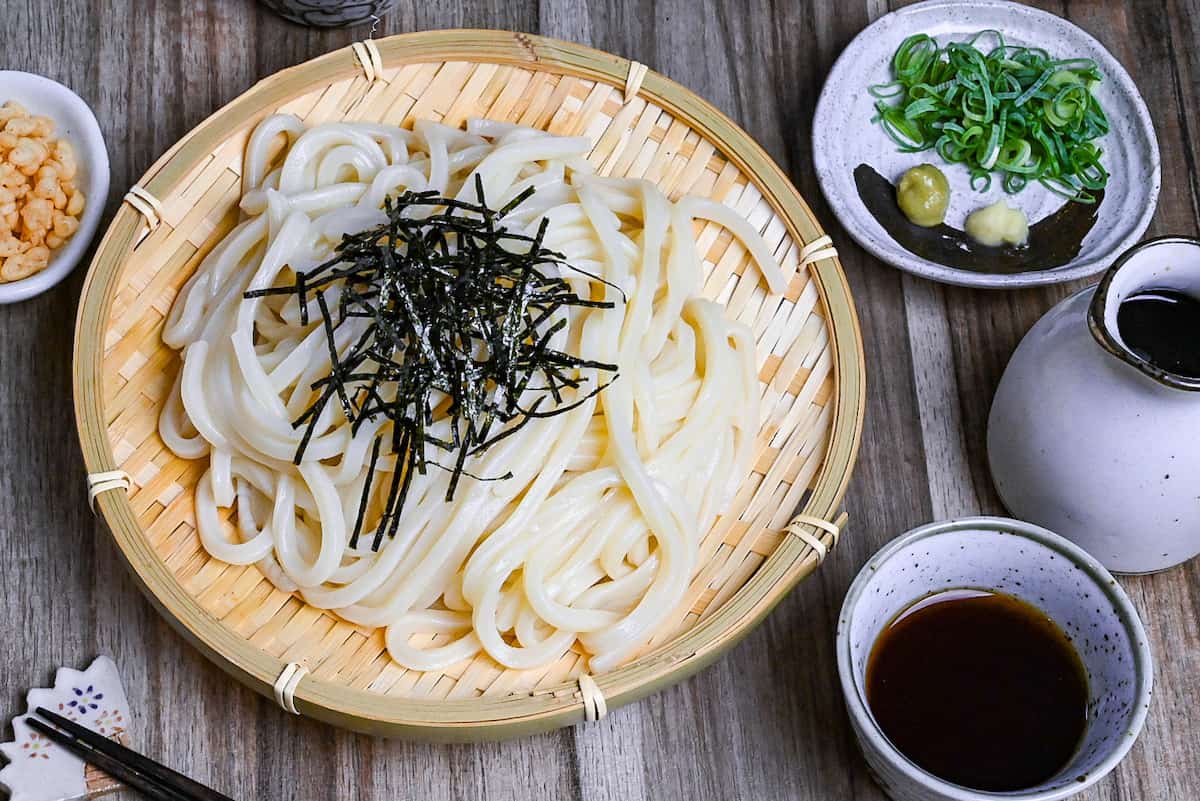
Zaru Udon Ingredients

- Udon noodles: You can use any type (fresh, chilled, dried, or frozen) but frozen udon gives you the best of both worlds, meaning authentic chewy texture without the fuss. If you’re feeling ambitious this weekend and want that “I made this from scratch” satisfaction, try my homemade udon noodles recipe!
- Mentsuyu: We’ll build this dipping sauce from scratch using dashi stock, Japanese soy sauce, mirin, and sugar. For dashi, instant granules or dashi packets work perfectly. If you’re short on time, store-bought concentrated tsuyu sauce (usually labeled “noodle soup base”) is totally acceptable.
- Toppings: Chopped green onions, freshly grated ginger, wasabi paste, and tempura flakes (tenkasu) are your flavor-boosting finishing touches that make this bowl feel complete.
How to Make My Zaru Udon
If you prefer to watch the process in action, check out my YouTube video of this recipe for a complete visual walkthrough!
i. Start by combining dashi stock, soy sauce, and mirin in a small saucepan over medium-high heat. Bring the mixture to a rolling boil and let it bubble for exactly one minute. This burns off the alcohol in the mirin and mellows its sweetness.
ii. Turn off the heat and stir in the sugar until it completely dissolves.
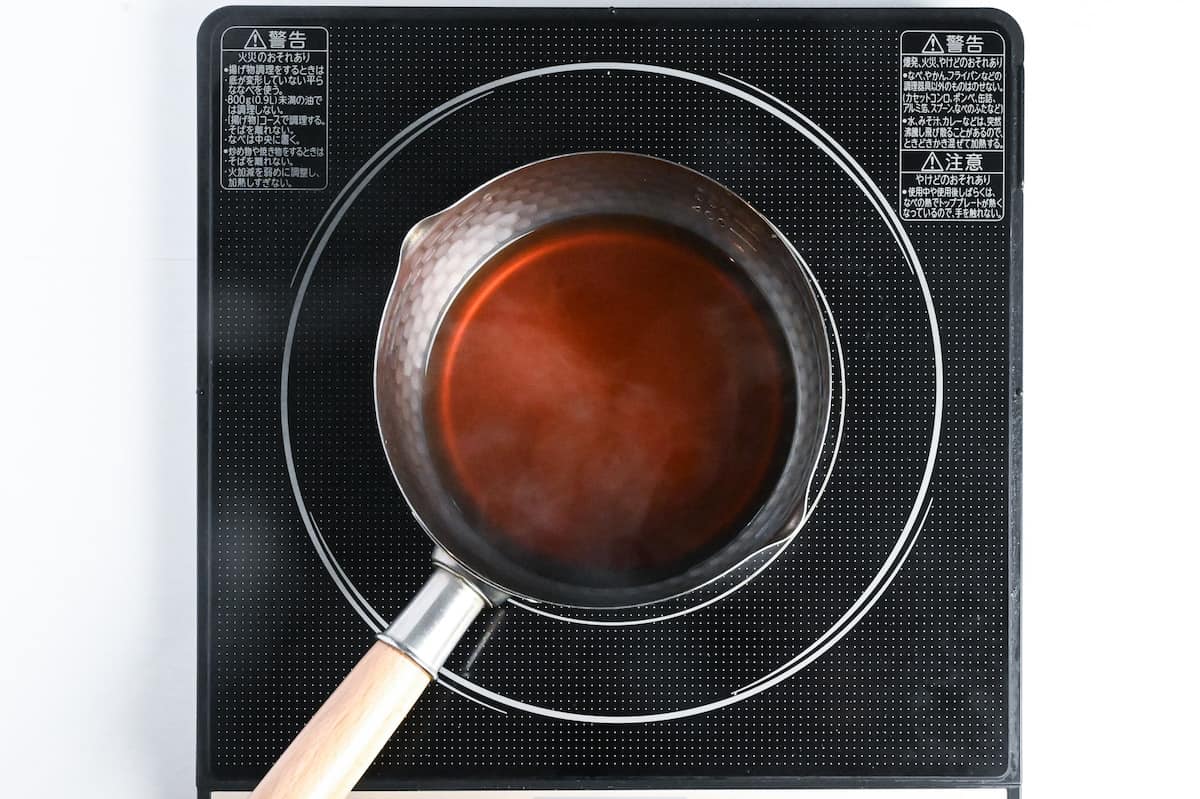
iii. Transfer your homemade mentsuyu to a heatproof pitcher or bowl and let it cool to room temperature. Once it’s cool to the touch, cover and refrigerate until serving time.
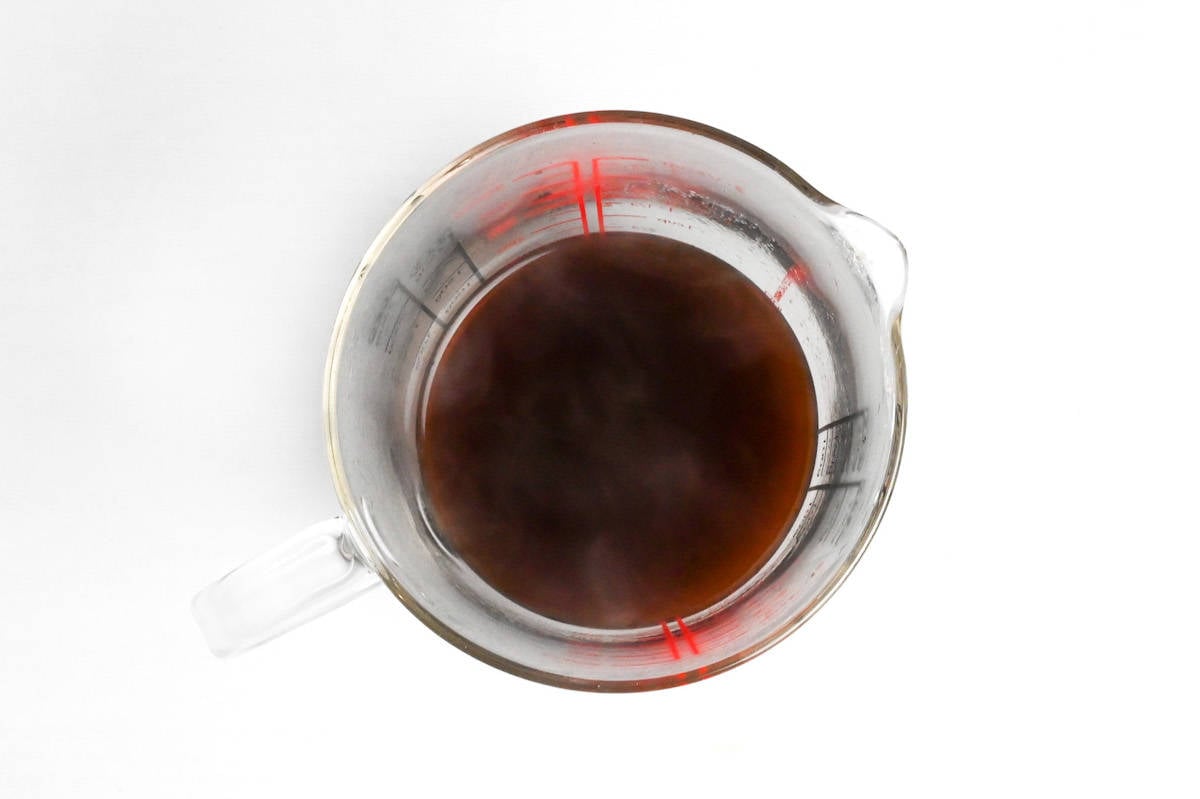
If you wanna make even quicker zaru udon, you can buy a bottle of tsuyu sauce (concentrated mentsuyu).
i. Bring a large pot of water to a rolling boil, at least 10× the noodles’ weight is a good measure. Add the udon noodles and resist stirring until the water returns to a boil as fragile fresh noodles can snap early.
ii. Keep the heat high so the water stays near 98-100°C (208-212°F) and the noodles “dance” freely. For cold zaru udon, cook a touch longer than for hot bowls, since chilling will firm them up later.
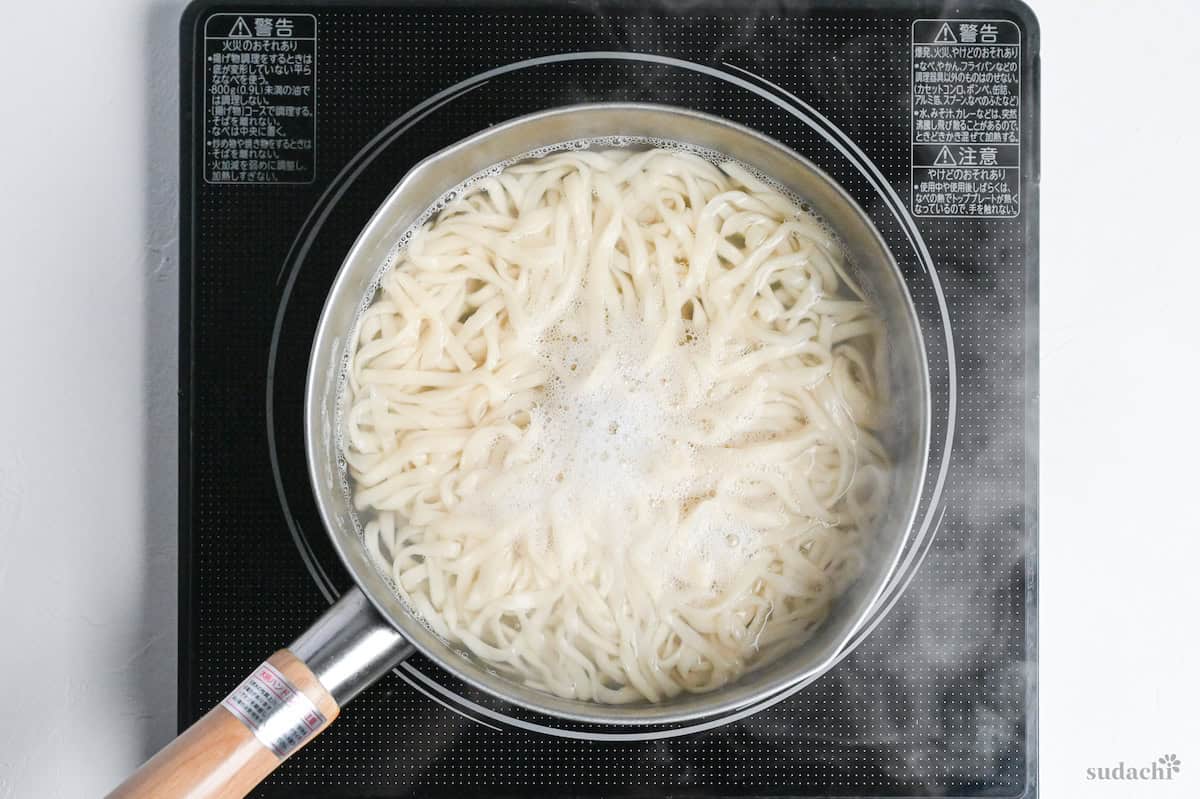
Plenty of boiling water prevents noodles from sticking and dilutes surface starch. It also keeps salinity steady so salt doesn’t “back-soak,” which can make noodles oddly briny. Foam surge? A quick stir or a splash of cold water tames it without derailing doneness.
i. Drain through a sieve and immediately rinse under cold running water. Massage the noodles gently between your fingers to wash off the slippery starch film.

ii. Dunk briefly in ice water to chill “to the core,” then drain very well.
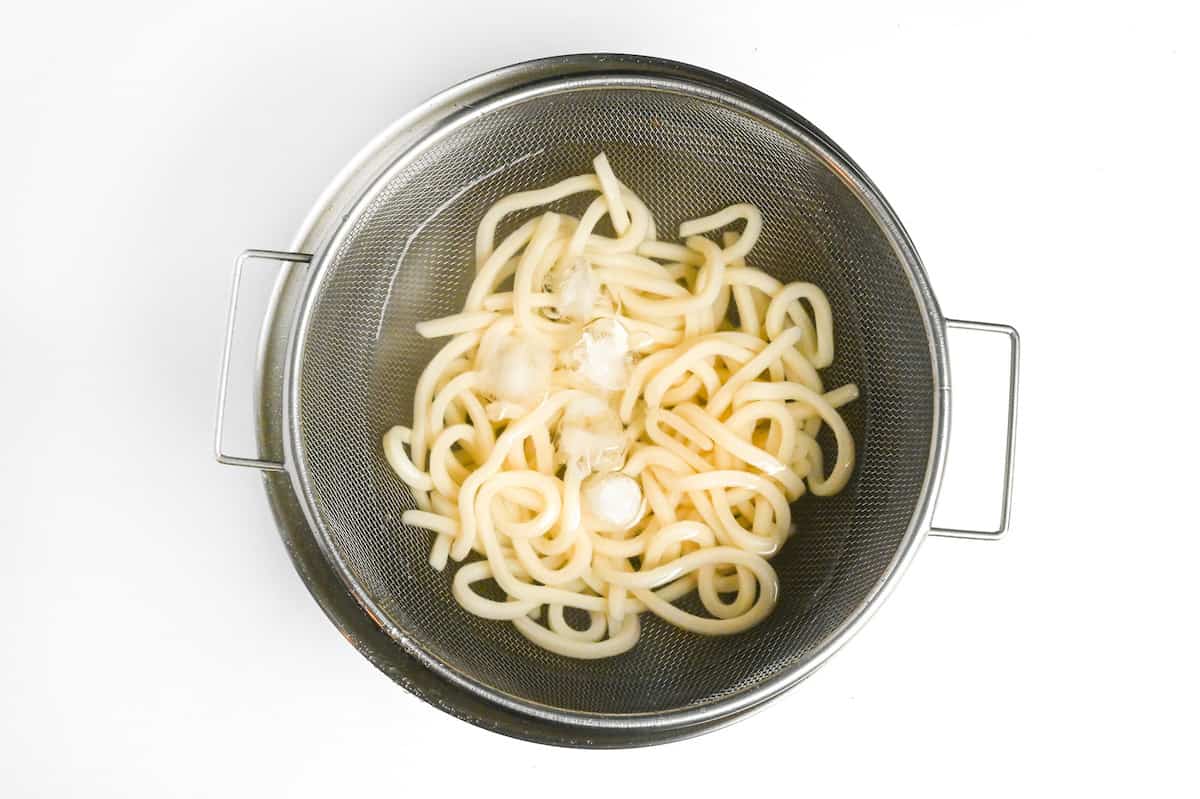
The sudden temperature drop causes the wheat proteins to contract and squeeze out excess moisture, creating a denser, more satisfying chew. Think of it like tempering steel, the rapid cooling makes the noodles stronger and more resilient.
i. Line up your flavor boosters so diners can tune their sauce to their own taste. Some options include:
- Finely chopped green onion
- Grated ginger
- A dab of wasabi
- Grated daikon
- Tenkasu (tempura bits)
- Ribbons of shiso/perilla
- Slivered myoga (ginger bud)
- Toasted sesame
- A citrus pop like sudachi
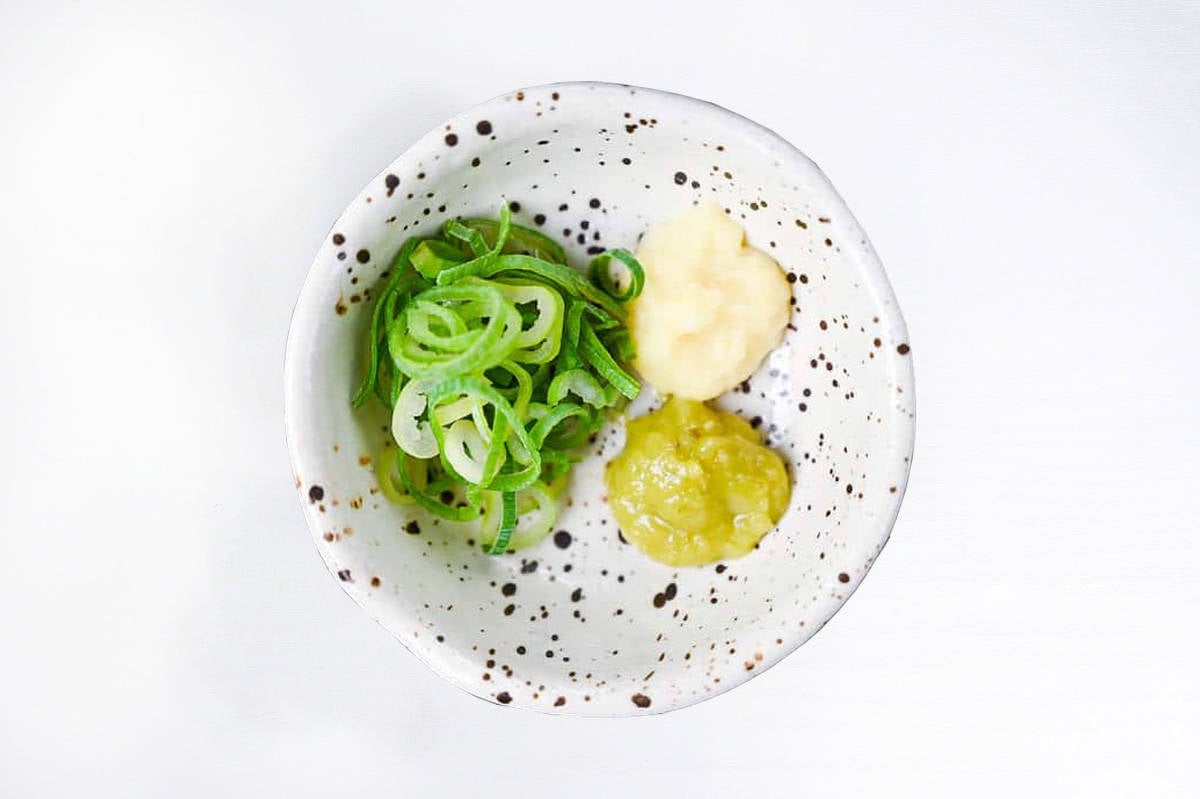
ii. Keep portions small, variety beats volume here. The goal is contrast: cool, clean noodles against bright aromatics, nutty crunch, and a little heat.
i. Mound the well-drained noodles on a zaru (bamboo draining tray) or a plate lined with a bamboo sushi mat. Top lightly with kizami nori (shredded roasted seaweed) for aroma.
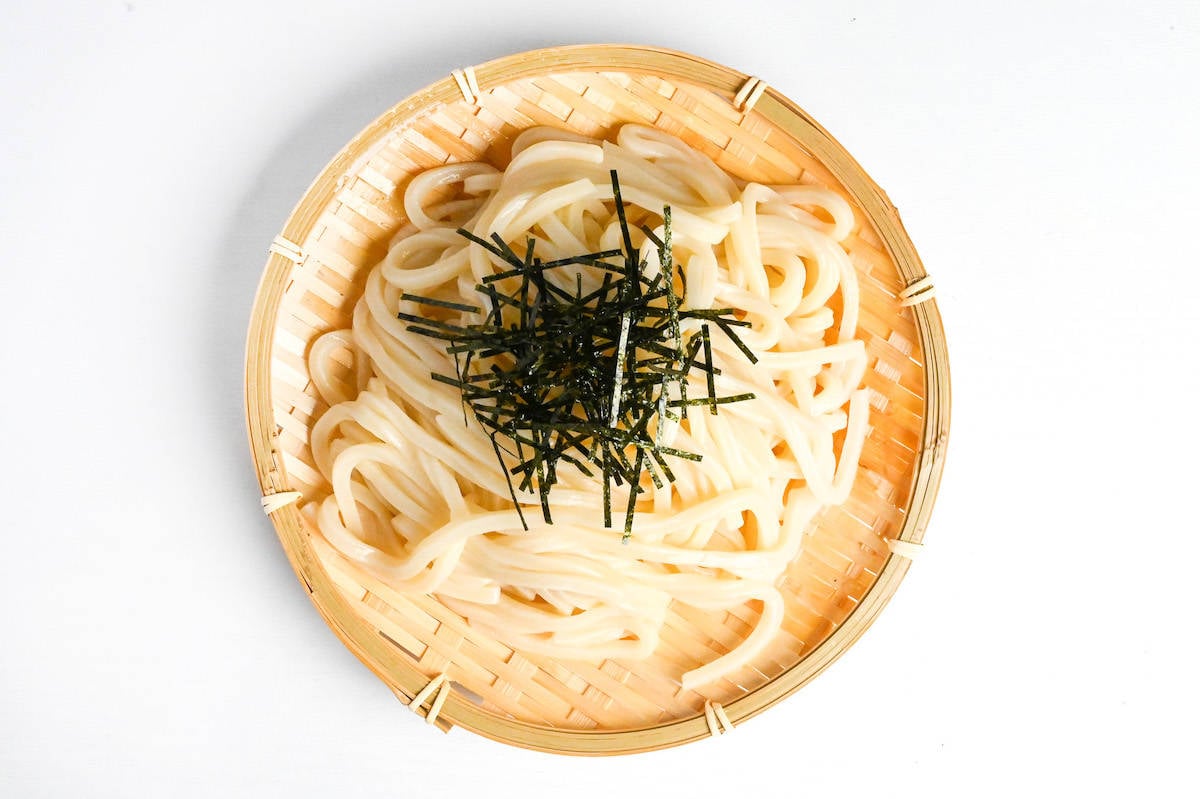
ii. Serve each person a cup of the chilled mentsuyu and a small plate of toppings. Personalization is the fun of zaru udon.
You can simply set a wire cooling rack or sushi mat over a plate.
i. Think dip-and-slurp, not soak-and-wait. Add a little of your chosen toppings to the mentsuyu, stir, then dip a small bundle of noodles for just a second. Slurp to pull air through the sauce.
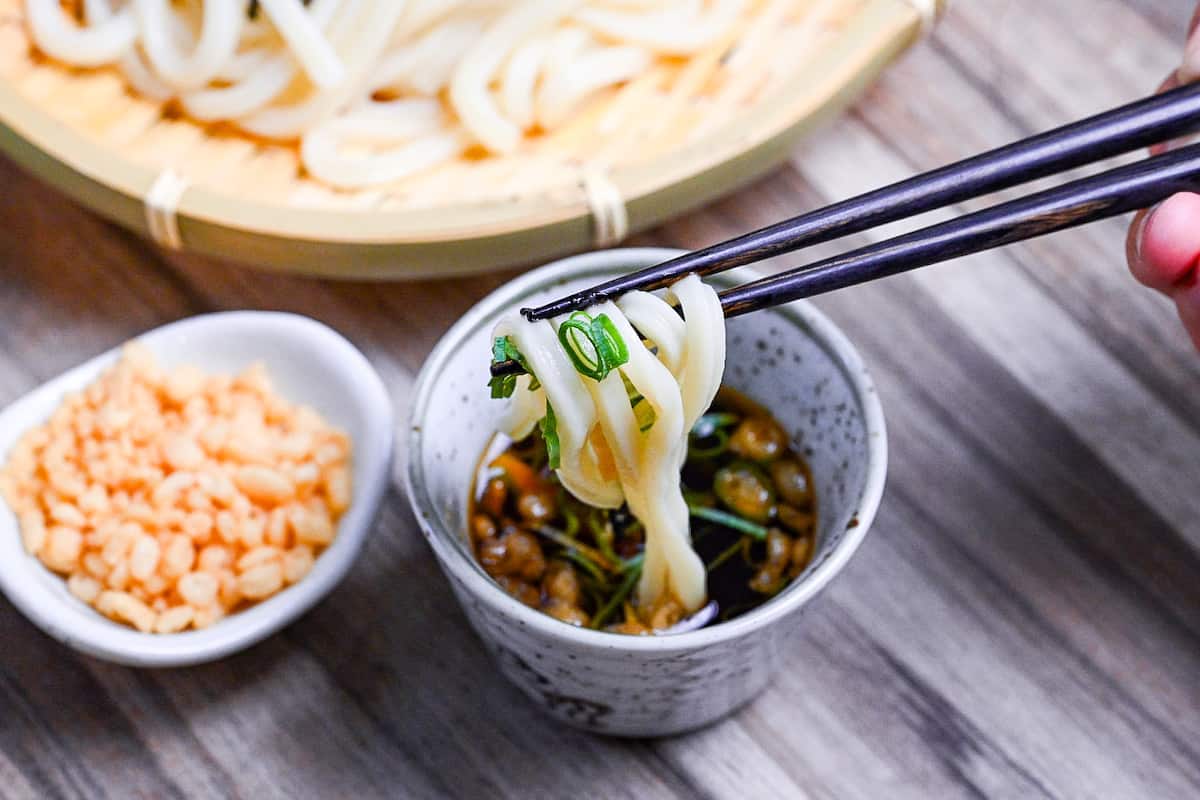
ii. Start simple to appreciate the wheat flavor, then build: a touch of ginger, a few scallions, maybe a sesame sprinkle. Adjust with a splash of cold water if the sauce tastes too intense.

Essential Tips & Tricks
- Use plenty of water to boil the udon (about 10× the noodles’ weight).
- Keep heat high so the noodles “dance” and the pot stays near 98-100°C (208-212°F).
- For cold zaru, cook slightly longer than for hot bowls as ice-chilling will firm the texture.
- Rinse immediately: drain, then massage under cold running water until the noodles feel squeaky, not slimy.
- Plate on a zaru or on a rack/mat set over a plate so noodles don’t sit in water.
With these simple tips in mind, you’re set for success every time you make zaru udon.
Storage & Meal Prep
Fridge: Mentsuyu (boiled): sealed jar, 5-7 days. Cooked udon: not recommended. If unavoidable, hold submerged in cold water up to 12 hours, but expect softer bite.
Freezer: Mentsuyu can be frozen in ice cube trays or tightly sealed freezer bags in individual portions for up to 1 month. Uncooked fresh udon: portion, dust with flour, wrap airtight, then bag up to 1 month. Cook from frozen.
Meal Prep: Not recommended for complete assembly. Make mentsuyu ahead (fridge 5-7 days or frozen cubes).
What to Serve With This Recipe
- Mixed tempura platter (shrimp, eggplant, sweet potato, perilla leaves)
- Chicken tempura (toriten)
- Japanese teriyaki chicken
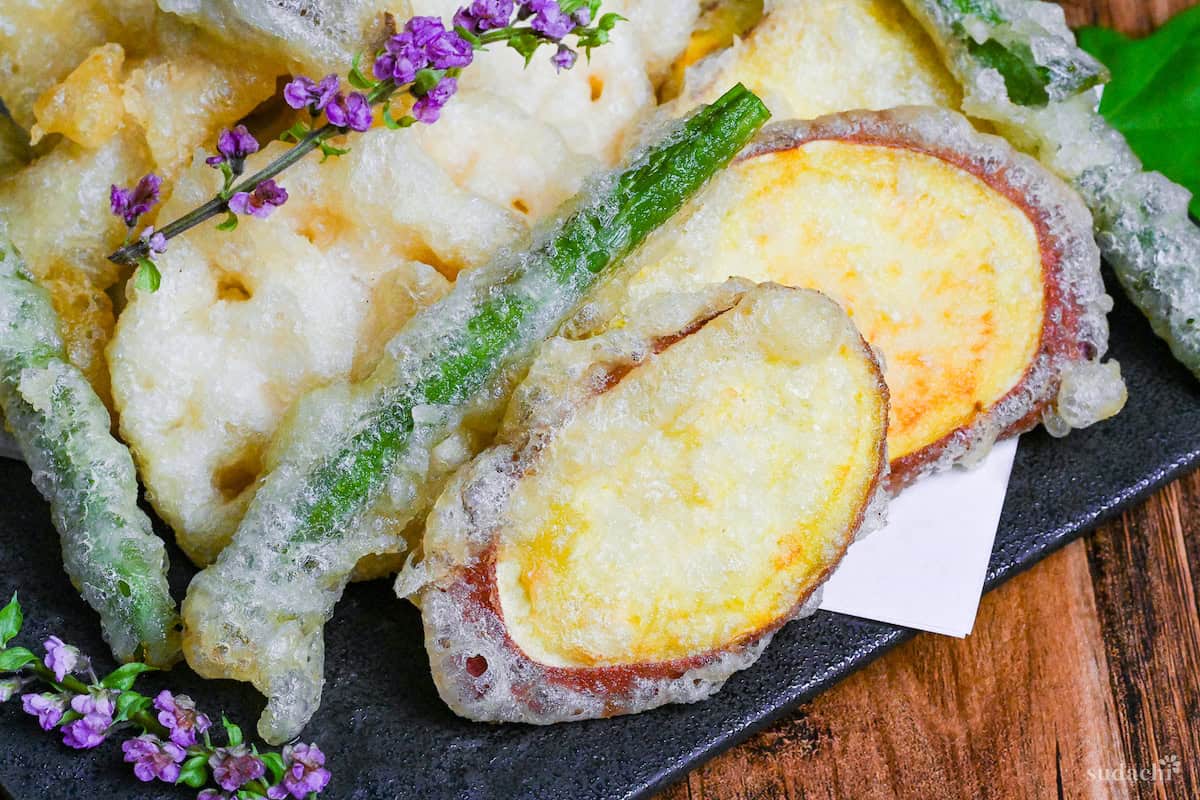
Zaru Udon FAQ
Zaru udon was specifically designed for throat sensation and texture. The creator reduced water content to make firmer dough (requiring twice as long kneading), rolled noodles longer for better slurping, and cut them thicker (chopstick-tip width) to enhance the experience.
If using concentrate, follow label and go slightly stronger if adding ice. For homemade that’s too salty, cut with dashi/water. If it’s too weak, add soy sauce to taste and sweeten with a little sugar or boiled mirin.
Plate right before eating. If you must wait, loosely cover with plastic wrap or splash with cold water briefly (don’t soak long or they’ll get waterlogged).
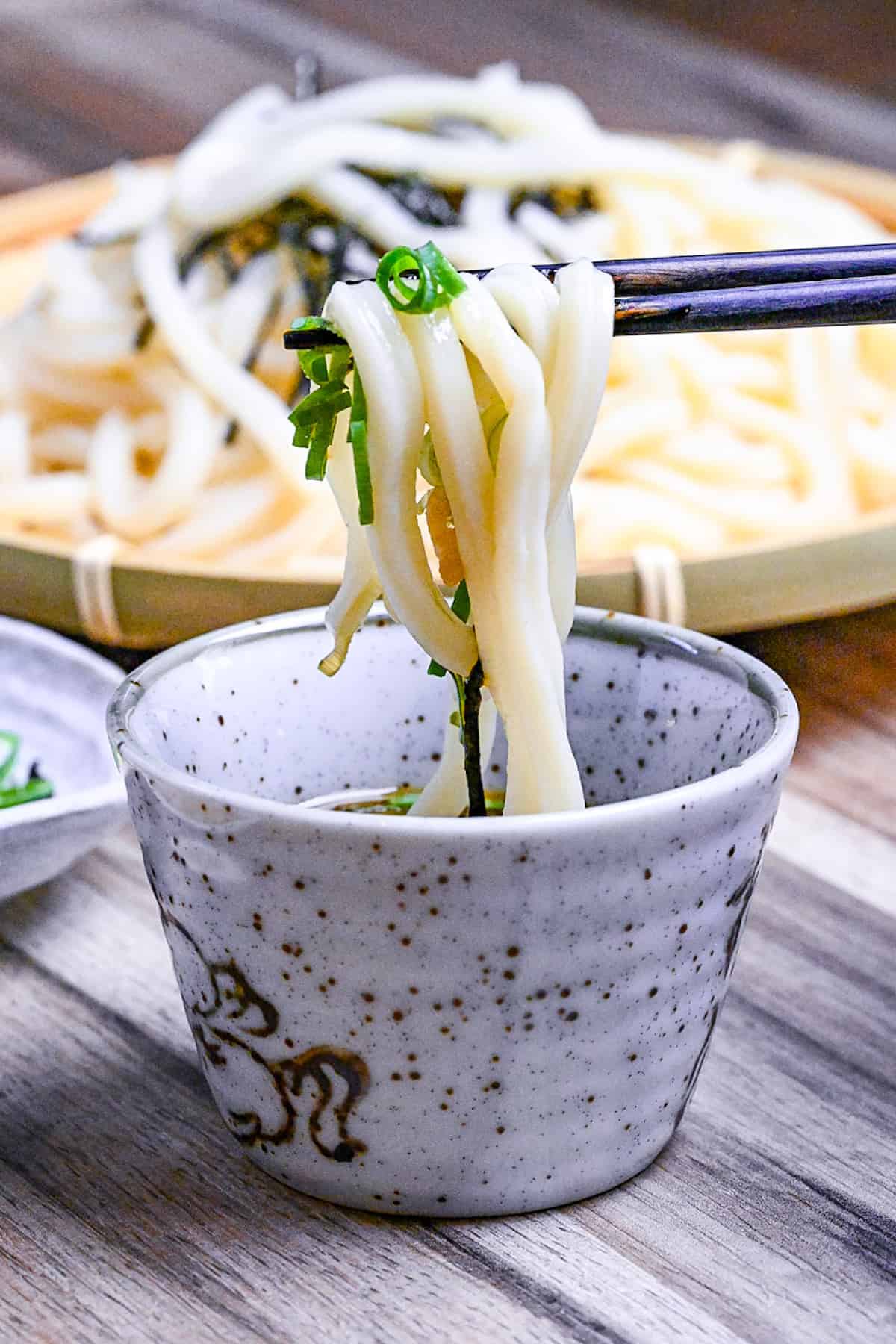
More Japanese Udon Recipes
- Chicken Yaki Udon (Udon Stir Fry)
- Kake Udon (Basic Udon Noodle Soup)
- Hiyashi Tanuki Udon
- Shrimp Tempura Udon
If you’re looking to expand your noodle repertoire, don’t miss my guide featuring authentic Japanese udon recipes from various regions.
Did You Try This Recipe?
I would love to hear your thoughts!
💬 Leave a review and ⭐️ rating in the comments below. 📷 I also love to see your photos – submit them here!
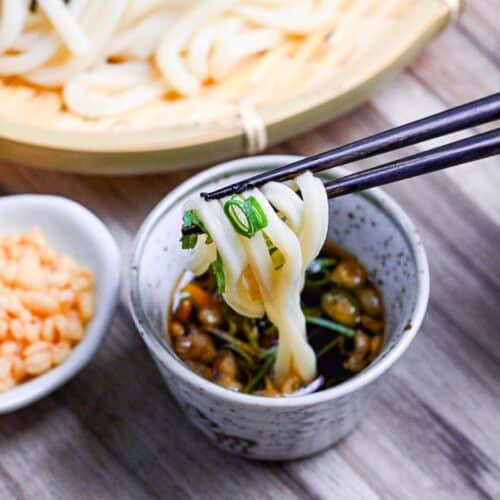
Zaru Udon (Cold Udon with Homemade Dipping Sauce)
Ingredients
- 200 ml dashi stock or make it plant-based with my shiitake and kombu dashi recipe
- 5 tsp Japanese soy sauce (koikuchi shoyu)
- 4 tsp mirin
- ½ tbsp sugar
- 2 portions udon noodles fresh, frozen, or dried
- kizami nori (shredded nori) optional garnish
Additions
- 1 tsp wasabi paste
- 1 tsp ginger root grated
- 2 tbsp tempura flakes (tenkasu) store-bought or homemade
- 2 tbsp finely chopped green onions
My recommended brands of ingredients and seasonings can be found in my Japanese pantry guide.
Can’t find certain Japanese ingredients? See my substitution guide here.
Instructions
- Take a small pan and add 200 ml dashi stock, 5 tsp Japanese soy sauce (koikuchi shoyu) and 4 tsp mirin. Boil for 1 minute to burn off the alcohol in the mirin and add ½ tbsp sugar. Mix until the sugar has dissolved.

- Take the pan off the heat, pour the dipping sauce into a heatproof jug and leave to cool. Once cool to the touch, you can transfer it to the refrigerator. Tip: Mixing will help it cool faster.

- Cook 2 portions udon noodles according the the instructions on the packaging. Once cooked, pour the udon into a strainer to drain and rinse with cold running water. Drain once more and place the sieve over a bowl, add a few ice cubes to make the udon extra cold.

- Take two small plates and to each one, add 1/2 tsp wasabi, 1/2 tsp grated ginger, 1 tbsp tempura flakes and 1 tbsp chopped green onion (all extras are optional).

- Place each serving of udon on a "zaru" and sprinkle with kizami nori. (You can use a bamboo sushi mat on a plate if you don't have a zaru.)

- Serve each portion of udon with a cup of cold mentsuyu dipping sauce and the small plate of ingredients to flavor the sauce.






Leave a rating and a comment